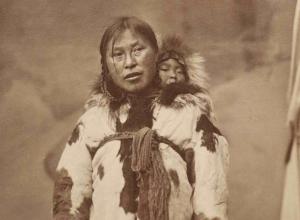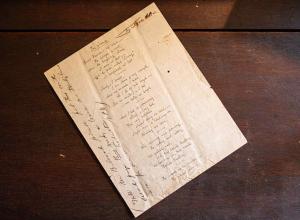"Woodland Views" Through July 27 at Hans P. Kraus Jr. Fine Photographs
New York - Woodland Views, an exhibition of work by photography’s early masters, is on view at Hans P. Kraus Jr. Fine Photographs through July 27, 2018. The exhibition presents primarily 19th century landscapes beginning in 1844 by William Henry Fox Talbot, John Dillwyn Llewelyn, Benjamin Brecknell Turner, Henri Le Secq, Roger Fenton, Gustave Le Gray, Joseph, vicomte Vigier, and Captain Linnaeus Tripe, among others.
Guided by Sir Walter Scott’s prose, William Henry Fox Talbot (1800-1877), the inventor of photography on paper, travelled to Scotland in October 1844 to photograph scenes from the life of Scott. Four converging triangles of alternating tones in Loch Katrine, a surprisingly modern 1844 salt print from a calotype negative, evokes a mood appropriate to Scott’s influential 1810 poem “Lady of the Lake.”
Pheasant and Ferns, an 1850s albumen print from a glass negative by the Welshman John Dillwyn Llewelyn (1810-1882), is a carefully observed tableau of a stuffed pheasant in a densely embroidered setting of ferns and ground cover and is a fine example of Llewelyn’s high regard for the medium.
Benjamin Brecknell Turner (1815-1894) first took up photography in 1849. Like many of the early practitioners he was a “gentleman amateur” for whom photography was a passion, not a profession. In the early 1850s he photographed picturesque, quintessentially English scenes: ruined abbeys and castles, thatched barns and half-timbered houses, crumbling cottages, ancient oak trees and woodland paths, such as the albumen print from a waxed calotype negative, In Loseley Park, from 1852-1854. Turner’s poetic images reveal the beauty of vernacular subjects and the moral worth of tradition, nature, and rural life.
Gustave Le Gray (1820-1884) trained as a painter in the studio of Paul Delaroche and exhibited in the Paris Salon. By the late 1840s Le Gray had become an innovator of photographic processes, developing the waxed paper negative around 1848. Saturating the paper with beeswax and light-sensitive chemicals made the image sharper than that resulting from the calotype process devised by Fox Talbot in the 1830s and 1840s. The waxed paper of Le Gray’s process could be prepared in advance and developed days after exposure allowing photographers to minimize the quantity of equipment in the field. Le Gray influenced a generation of 19th century photographers including J. B. Greene, vicomte Vigier, Henri Le Secq, and Roger Fenton.
Le Gray’s own exceptional vision is reflected in his landscapes and seascapes. His poetic photographs taken in the forest of Fontainebleau are masterpieces of light and shadow. The exhibition includes Le Hêtre, Fontainebleau, an albumen or coated salt print from a waxed paper negative, dating from the early 1850s.
A student of Le Gray, Joseph, vicomte Vigier (1821-1894) produced a series of work from paper negatives in the Pyrenees in the summer of 1853. Bagnères de Luchon. Chemin trace par l’avalanche dans la forêt de Saint-Just, a fine salt print, evokes the sublime by depicting a mountain slope devastated by an avalanche. Vigier’s ambitious views of the Pyrenees earned unanimous praise from his contemporaries as proof of the universal and timeless language of photography.
Rangoon. The Great Bell at the Shwe Dagon Pagoda, Burma an albumenized salt print from a waxed paper negative of 1855 by Captain Linnaeus Tripe (1822-1902), features a majestic tamarind tree towering over a pagoda which it nearly obscures, the Great Bell just visible beneath the tamarind’s overspread branches and leaves. Tripe was the official photographer attached to a British diplomatic mission to Burma in 1855, instructed to gather information regarding the country and its people. Tripe’s architectural and topographical views are of great documentary importance as they are among the earliest surviving photographs of Burma.
Attributed to the Circle of the sculptor Charles Simart, two 1850s salt prints from enlarged collodion negatives, Branch of apples and Apple blossoms, are charged with the same energy as quick pencil sketches in an artist’s sketchbook. Made by an unidentified photographer with barely a nod to conventional practice, these prints are filled with a great sense of purpose. The apple tree details were photographed from life and feature the sharp resolution associated with prints made from collodion negatives. Appearing at first glance to be enlargements from smaller negatives these contact prints from enlarged copy negatives, make the familiar strange.















